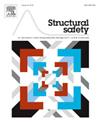Branch-and-bound algorithm for efficient reliability analysis of general coherent systems
IF 6.3
1区 工程技术
Q1 ENGINEERING, CIVIL
引用次数: 0
Abstract
Branch-and-bound algorithms, also known as bounding or decomposition algorithms, have been developed for reliability analysis of coherent systems. They can find a computationally efficient representation of a system failure or survival event, which can be re-used when the input probability distributions or reliabilities change, for example with time or when new data is available. Existing branch-and-bound algorithms can handle only a limited set of system performance functions, mostly network connectivity and maximum flow. Furthermore, they run redundant analyses on component vector states whose system state can be inferred from previous analysis results. We address these limitations by proposing the branch-and-bound for reliability analysis of general coherent systems (BRC) algorithm: an algorithm that automatically finds minimal representations of failure/survival events of general coherent systems. Computational efficiency is attained by dynamically inferring importance of component events from hitherto obtained results. We demonstrate advantages of the BRC method as a real-time risk management tool by application to the Eastern Massachusetts highway benchmark network.
一般相干系统高效可靠性分析的分支定界算法
分支定界算法,也称为定界或分解算法,已被发展用于相干系统的可靠性分析。它们可以找到系统故障或生存事件的计算效率表示,当输入概率分布或可靠性发生变化时,例如随着时间的推移或当有新数据可用时,可以重用这些表示。现有的分支定界算法只能处理有限的系统性能功能,主要是网络连接和最大流量。此外,他们对组件矢量状态进行冗余分析,系统状态可以从先前的分析结果中推断出来。我们通过提出一般相干系统可靠性分析的分支定界算法(BRC)来解决这些限制:一种自动找到一般相干系统故障/生存事件的最小表示的算法。通过从迄今为止获得的结果动态推断组件事件的重要性来获得计算效率。通过将BRC方法应用于马萨诸塞州东部公路基准网络,证明了BRC方法作为实时风险管理工具的优势。
本文章由计算机程序翻译,如有差异,请以英文原文为准。
求助全文
约1分钟内获得全文
求助全文
来源期刊

Structural Safety
工程技术-工程:土木
CiteScore
11.30
自引率
8.60%
发文量
67
审稿时长
53 days
期刊介绍:
Structural Safety is an international journal devoted to integrated risk assessment for a wide range of constructed facilities such as buildings, bridges, earth structures, offshore facilities, dams, lifelines and nuclear structural systems. Its purpose is to foster communication about risk and reliability among technical disciplines involved in design and construction, and to enhance the use of risk management in the constructed environment
 求助内容:
求助内容: 应助结果提醒方式:
应助结果提醒方式:


